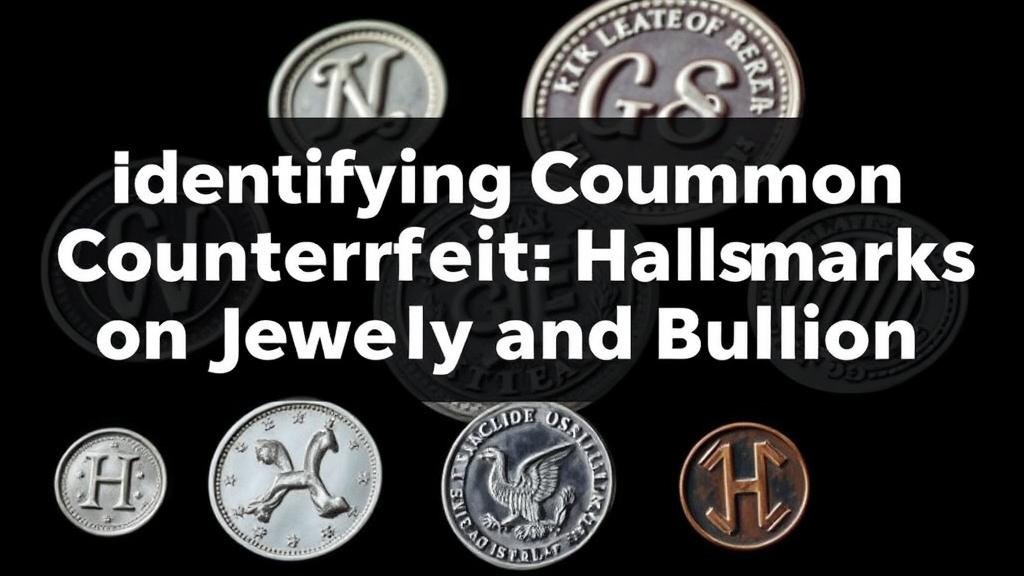Identifying Common Counterfeit Hallmarks on Jewelry and Bullion
Identifying Common Counterfeit Hallmarks on Jewelry and Bullion
The allure of precious metals and gemstones has led to a thriving market for jewelry and bullion. But, this has also resulted in an increase in counterfeit items that deceive unwary buyers. Understanding how to identify common counterfeit hallmarks is crucial for both collectors and investors. This article discusses key indicators of counterfeit jewelry and bullion while providing practical guidance for differentiation.
The Importance of Hallmarks
Hallmarks are standardized stamps that indicate the purity of a metal or the authenticity of an item. For bullion, they often include information like the assay office and the weight of the metal. For jewelry, hallmarks can denote the maker, the metal content, and the country of origin. Recognizing these marks can help in verifying the legitimacy of a piece.
Common Types of Counterfeit Hallmarks
- Fake Assay Marks: Many counterfeit items display fake assay marks to mimic authenticity. Genuine items typically have distinct hallmarks that are regulated by governing bodies.
- Incorrect Metal Composition: Some counterfeit jewelry may be marked with a higher karat number to suggest it is made of purer gold, when in fact it is not.
- Missing Hallmarks: Legitimate jewelry and bullion should always have some form of hallmark. Absence of marks can be an indicator of a counterfeit.
Identifying Counterfeit Jewelry
To distinguish real jewelry from counterfeit pieces, one must look closely at a variety of factors, including craftsmanship, weight, and hallmark details.
Craftsmanship
High-quality jewelry features meticulous craftsmanship. For example, real diamond jewelry tends to have even settings, while counterfeit versions may display uneven settings or poorly soldered seams. Noting these details can provide insight into authenticity.
Weight and Feel
Genuine precious metals like gold and silver have distinct weights. For example, a one-ounce gold coin should weigh exactly one ounce. Counterfeits that use lighter materials may have an unusual feel compared to authentic pieces.
Check Common Hallmarks
To verify jewelry, familiarize yourself with common hallmarks. For example, the American standard for gold is commonly marked as “10K,†“14K,†or “18K.†Familiarizing oneself with these markings can reveal discrepancies that suggest counterfeiting.
Identifying Counterfeit Bullion
When it comes to bullion, the stakes are high, and the risks are equally significant. Counterfeit bullion can be especially challenging to identify due to its often high-quality replication.
Examining the Aesthetic
Authentic bullion usually has a crisp and clear design with distinct lines. Counterfeit versions may display smudged details or inconsistent engraving. For example, the American Eagle bullion coins are known for their recognizable features; any variation in the design could be a red flag.
Weight and Measurement
Just like jewelry, bullion should match standardized weight expectations. Using a scale that measures in troy ounces can help verify if the weight aligns with known specifications. For example, a one-ounce silver coin should weigh exactly one ounce troy.
Magnet Test
Precious metals, especially gold and silver, are non-magnetic. A simple magnet test can quickly differentiate genuine pieces from counterfeit ones. If a coin or piece of jewelry attracts a magnet, it likely contains other metals that are commonly used in counterfeiting.
Conclusion and Actionable Takeaways
In a market where counterfeit jewelry and bullion are increasingly prevalent, being informed is your strongest ally. Always verify hallmarks, evaluate craftsmanship, and conduct weight tests. Familiarize yourself with reputable sources that detail official hallmarks for specific gemstones and metals. By following these guidelines, consumers can better protect themselves and their investments against fraud.
- Consult with certified appraisers when in doubt about a piece.
- Use a jewelers loupe to closely inspect hallmark clarity and quality.
- Stay educated about the latest counterfeiting techniques.



